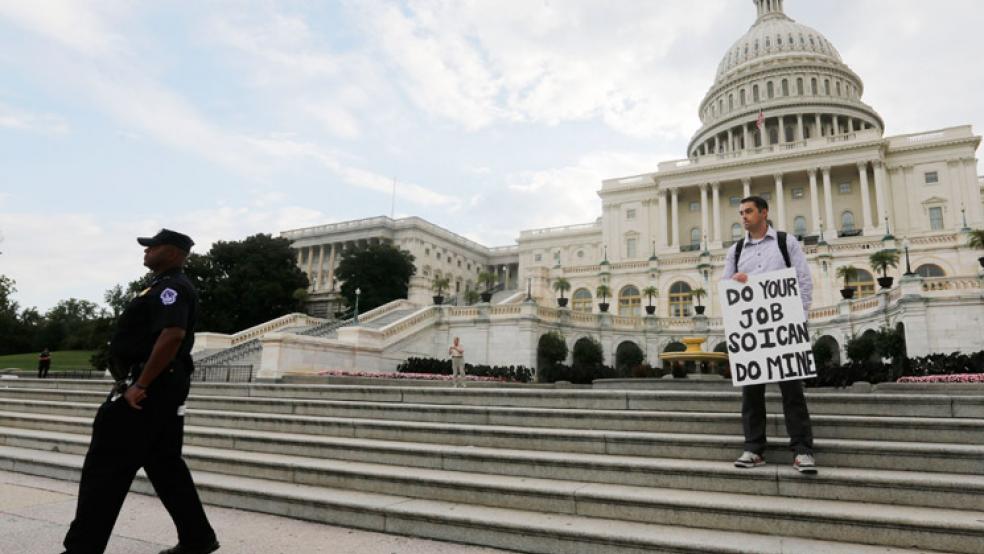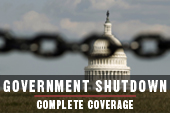In Washington on Tuesday morning, hundreds of thousands of federal workers were given a few hours to clear off their desks and head home to an uncertain future as the first day of the government shutdown took hold.
As the clock struck midnight Monday, OMB Director Sylvia M. Burwell said federal agencies should begin executive plans “for an orderly shutdown due to the absence of appropriations.” That means, with no deal in sight for a short-term extension of government spending, departments and agencies had to make final decisions on which of their workers are essential to the safe and efficient operation of government, and which ones could be sent home.
RELATED: THE SHOCKING COST TO TAXPAYERS OF A SHUTDOWN
More than 800,000 federal workers in D.C. and across the country are being furloughed for the duration of the shutdown. That means they will be on enforced leave with no pay – with uncertain prospects for being reimbursed for lost pay. Congress reimbursed furloughed workers after the last government shutdown in 1995-1996, but there is no guarantee that today’s sorely divided Congress will make the same decision.
About 1.4 million active-duty military personnel, some reservists and about 1.3 million civilian federal workers will be required to report to work and will be entitled to be paid. However, even their paychecks could be delayed if the shutdown drags on.
RELATED: THE MOST LUDICROUS PART OF A GOVERNMENT SHUTDOWN
Here is a brief guide for government workers and average Americans in understanding the immediate impact of the shutdown:
While active members of the military will be exempted, about half the Defense Dept.'s civilian workforce – or 400,000 men and women - will be furloughed.
Nearly all of the Commerce Dept.'s 46,420 employees will be sent home without pay, as will all but a handful of the Dept. of Education’s 4,225 full- and part-time workers and NASA’s 18,250 employees.
Other departments and agencies hard hit by furloughs include the Dept. of Energy (except for the office overseeing the safety of nation’s nuclear arsenal and the agency in charge of dams and transmission lines), the Environmental Protection Agency, the Dept. of Health and Human Services, the Federal Transit Administration, the Dept. of Housing and Urban Development, the Interior Dept. and the Small Business Administration.
With negotiations over a short-term spending bill in tatters on Capitol Hill, the telltale signs of the first government shutdown in 17 years can be seen everywhere:
* The National Park Service has barricaded the monuments and memorials on the Mall and turned off its 45 fountains. That means tourists and visitors are being turned away from the Lincoln Memorial, the Franklin Delano Roosevelt Memorial, Jefferson Memorial and other prominent sites.
* The Smithsonian and Holocaust museums are closed, as is the National Zoo, which has turned off its popular webcast of the baby panda.
* Public tours of the Capitol and the National Archives are canceled.
Below the surface, some important government services will also be disrupted or curtailed. The WIC program that provides food to low-income women and young children will run dry of funds, the IRS’s phones for customer service will be cut off, the Veterans Administration may be slow in responding to calls about benefits, and while Social Security checks will go out on time, new applications for coverage may not be processed until after the shutdown.
RELATED: FISCAL FIASCO: WILL SHUTDOWN CAUSE STOCK MELTDOWN?
Also, the Executive Office of the president will furlough about 1,265 staff members and keep 436 as "excepted" workers. Among those retained will be 15 to provide "minimum maintenance and support" for the White House. Executive agencies will be trimmed to the bare minimum, including four at the Council of Economic Advisers. The U.S. will also cease publishing most of its economic data, including the closely followed monthly employment reports.
ON THE POSITIVE SIDE ...
The U.S. Postal Service will continue to deliver mail, federal courts will continue to operate, meat and poultry inspectors will still show up for work and the food stamp program will continue providing assistance to the poor. The District of Columbia government, whose spending is subject to congressional review, has declared the entire city workforce “essential.”
That means the city will continue to deliver all services, including garbage pickup. (Garbage piled up in the city 17 years ago during the last government shutdown when many city services were curtailed.)
And while many federal departments and agencies will be hit hard by furloughs, a few are dodging that bullet - largely because of how they're funded.
These include:
* The Federal Reserve and the U.S. Postal Service, which are both self-funded.
* The Dept. of Homeland Security, where about 86 percent of employees will continue working. The Transportation Security Administration, Federal Emergency Management Agency, Coast Guard, Customs and Border Patrol, Immigration Services and Secret Service all will stay open and rremain staffed near capacity.
* The Justice Dept. will keep a majority of its 96,744 employees on the job. All agents at the FBI, Drug Enforcement Administration and Bureau of Alcohol, Tobacco, Firearms and Explosives are exempt from furloughs.
* The State Dept. will remain in full operation; it will continue its passport operations and visa processing. Embassies and consulates will also stay open.
* The Supreme Court and its staff will operate unscathed throughout the shutdown, as they have in the past.
* Passport inspectors, security officers and air traffic controllers will all continue to work as usual, so air and rail travelers in the U.S. should feel virtually no impact.







